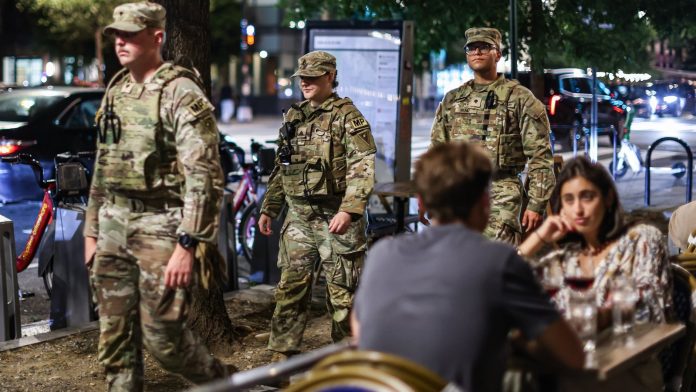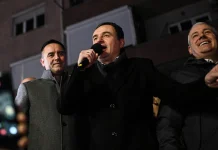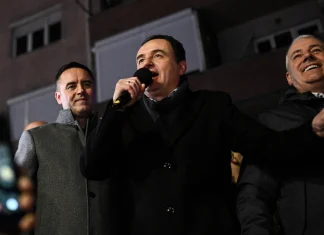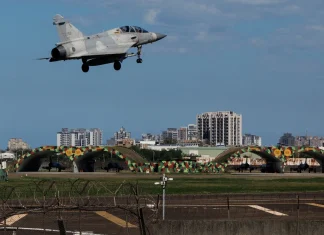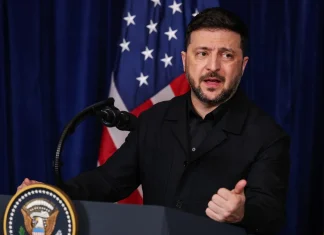When Washington’s Streets Turned Into a Showdown: A Tale of Troops, Tensions, and Turf Wars
Picture this: the streets of Washington, D.C., a city renowned for its iconic monuments and political gravitas, transformed overnight—not by celebrations or protests, but by the steady, watchful presence of National Guard troops. It was a scene reminiscent of a city on edge, caught between calm and chaos, between law and order and the looming shadow of unrest.
This is the story of a bold, contentious move by then-President Donald Trump, whose drive to clamp down on what he described as a crime wave would change the face of America’s capital—and potentially other cities—in ways that sparked fierce debate nationwide.
The Arrival of Armed National Guard Troops: A New Chapter in a City’s Story
For more than two weeks, hundreds of National Guard troops had quietly mingled with the rhythms of the capital’s daily life—unarmed, their presence more advisory than confrontational. But then, a pivotal shift: as of last night, a contingent of these troops was officially authorized to carry weapons—M17 pistols or M4 rifles—as told to me by two insiders privy to the operation who wished to remain unnamed. This change heralded a more assertive stance, signaling that the federal government viewed the situation not as a mere law enforcement challenge but a security imperative.
In a statement from the Guard’s Joint Task Force-DC, the personnel committed themselves to a code that resonates even in the most fraught moments: force would only be a ‘last resort,’ reserved exclusively for ‘an imminent threat of death or serious bodily harm.’ Yet, the image of troops on patrol, weapons drawn and ready, stirred up anxieties among residents and commentators alike.
“It feels like a city preparing for war rather than peace,”
shared Marie Johnson, a lifelong D.C. resident and local shop owner. “I understand the need for safety, but there’s a difference between protection and intimidation.”
Her words tap into the crux of the matter. How much security is enough? And when does it start to fray the delicate fabric of civil liberties? These are questions that countless Americans wrestled with as Washington balanced on this razor’s edge.
Beyond the Capital: The Shadow Looms Over Chicago and Baltimore
President Trump didn’t stop with the capital. In speeches and social media outbursts, he floated the idea of extending the National Guard deployment to cities like Chicago and Baltimore—two metropolises with storied histories, vibrant cultures, and marked political leanings toward Democratic leadership.
In Chicago, where the winds off Lake Michigan sweep through neighborhoods steeped in jazz, food, and community resilience, the suggestion drew fire. Hakeem Jeffries, then Minority Leader of the House of Representatives, slammed Trump’s plan as an unconstitutional overreach and partisan grandstanding.
“There’s no lawful basis, no genuine emergency that justifies federal troops patrolling the streets of Chicago,” Jeffries told CNN’s “State of the Union.” “This is manufactured crisis for political gain.”
Indeed, statistics from the Chicago Police Department painted a different picture. Murders had actually declined over the past year—a glimmer of hope piercing narratives of decline. JB Pritzker, Illinois’ Democratic governor, echoed this sentiment, labeling any National Guard deployment unnecessary.
Meanwhile, in Baltimore, a city with a proud maritime heritage and a soul shaped by art, music, and a tenacious spirit, the conversation was equally charged. Despite falling gun violence rates and the fewest homicides in over half a century (84 so far that year, according to the mayor’s office), Trump warned Governor Wes Moore he was ready to intervene if “help” was required.
Local veteran and community activist Damon Harris sees the president’s words as a misunderstood signal. “Baltimore has suffered real pain, real loss, but our progress is real, too. Military boots aren’t the answer—community programs, police reform, and economic investment are.”
Between Authority and Autonomy: The Constitutional Chess Game
The legalities tethering the president’s power to deploy troops domestically are complex, woven with historical precedents and constitutional provisions.
Under Title 10 of the U.S. Code, the commander-in-chief holds the power to deploy National Guard forces to:
- Repel invasions
- Suppress rebellions
- Execute the law—under certain conditions
Yet, this authority is far from absolute when it comes to intervening in states without their consent, especially in cities governed by Democrats where local laws sometimes clash with federal policies—take sanctuary cities, for example.
Trump had previously invoked Section 12406 earlier in the year to justify sending troops to California amid protests, bypassing Governor Gavin Newsom’s objections. Applying similar logic to Chicago and Baltimore, however, raised numerous red flags.
Legal experts predicted fierce court battles would erupt if such deployments were attempted without state approval, highlighting an ongoing tension between federal power and state sovereignty.
The Bigger Picture: Crime, Politics, and the Pulse of a Nation
This unfolding drama raises profound questions that ripple far beyond the immediate headlines.
- What does “security” really mean in a democracy?
- How do we balance safety with freedom, order with justice?
- Can deploying armed troops in American cities be a viable solution—or is it a symptom of deeper divisions and mistrust?
For many Americans, the presence of troops on city streets conjures memories of unrest, crackdowns, and unequal application of justice. So it’s no surprise that reactions from policymakers, communities, and experts have ranged from cautious support to outright condemnation.
As Marie Johnson, the shop owner from D.C., poignantly asks,
“When does protection become oppression? And who decides?”
Inviting Reflection: What Does the Future Hold?
As you read this, imagine yourself standing on the corner of Pennsylvania Avenue, or walking along Baltimore’s Inner Harbor, or savoring a Chicago deep-dish slice in a bustling neighborhood. What do you feel? Safety? Tension? Hope? Fear?
In an era marked by polarized politics and social fragmentation, the answers aren’t simple. This story—of armed troops, politics clashing with policy, and cities fighting their demons—is a microcosm of challenges that face democracies worldwide.
Will future solutions come in the form of more boots on the ground? Or will communities forge new paths through dialogue, investment, and justice reform?
History tells us that how we answer these questions shapes the soul of a nation.
So, dear reader, as the dust settles on this episode of America’s ongoing experiment, I leave you with this: in the quest for peace and order, what price are we willing to pay, and who are we willing to become?


